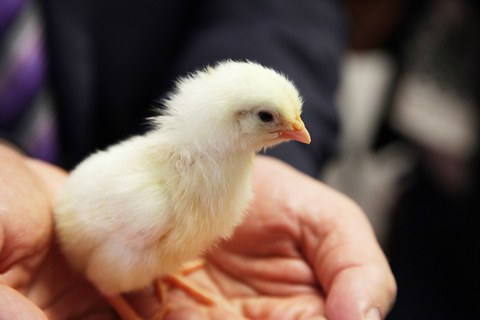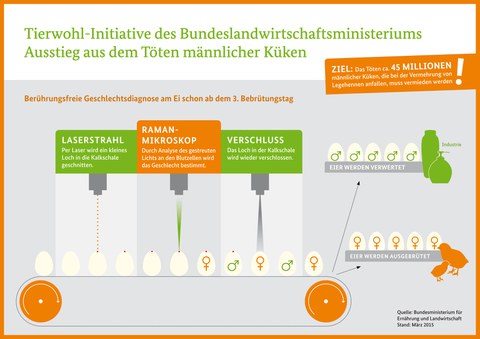In ovo sexing of chicken eggs (Gallus gallus f. dom.) as alternative for routine culling of day-old male chicks of laying hen strains
Every year, only in Germany about 40 millions of male chicks of laying hen strains are sorted out and killed immediately after hatching according to regulations for animal protection and slaughter by asphyxiation with carbon dioxide or by grinding. The problem of killing unwanted day-old male chicks affects all areas of keeping laying hens, including the organic sector, but rises more and more ethical and legal concerns. Our research project is aimed at developing a practical procedure, which allows a reliable sex determination prior to hatching. In the future, the sex will be determined by optical spectroscopic methods on day three of incubation, when the embryo does not feel any pain yet.
Raman spectroscopy uses monochromatic light, which shines on the studied object and the spectrum of the scattered light is analyzed. The structure of molecules can be clearly determined by analyzing the bands of the Raman spectrum. Ultraviolet (UV) light is used for stimulation the Raman scattering, while especially DNA and protein information are intensified by the so-called resonance effect. By applying low-energy near-infrared light, this measuring principle can be also used for in ovo sexing. For this purpose, the scattered Raman light of embryos being incubated for about 72 hours is registered and spectrally resolved. Raman spectra of male blood cells show a slightly lower signal in the range of nucleic acids compared to female blood cells. These signals differ significantly and can be used for sex identification.
Currently we are working on further increasing the reliability of sexing and optimizing the hatching rate. For a large-scale industrial use, the speed of this method has to be increased considerably. A further focus is the development of a fully automated selection. We hope to achieve this aim by summer 2017.
Funding
Federal Ministry of Food and Agriculture
Cooperations
Prof. Dr. M.-E. Krautwald-Junghanns, PD Dr. T. Bartels, Dr. K. Cramer, Universität Leipzig, Klinik für Vögel und Reptilien
Prof. Dr. R. Preisinger, Dr. A. Förster, Lohmann Tierzucht GmbH
Prof. Dr. F. Kremer, Dr. E.U. Mapesa, Dipl.-Ing. J. Reinmuth, Dipl.-Phys. V. Skokow, Universität Leipzig, Institut für Experimentelle Physik I
Dr. Sven Meißner, Dipl.-Ing. (FH) B. Fischer, EVONTA-Technology GmbH
Contact
 © Jonas Golde, KSM
© Jonas Golde, KSM
Mr apl. Prof. Dr. rer. nat. habil. Gerald Steiner
Send encrypted email via the SecureMail portal (for TUD external users only).
Clinical Sensoring and Monitoring
Clinical Sensoring and Monitoring
Visiting address:
Medizinisch-Theoretisches Zentrum (MTZ - Haus 91) Fiedlerstraße 42
01307 Dresden

